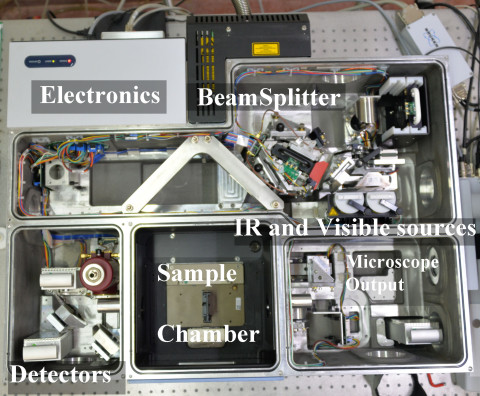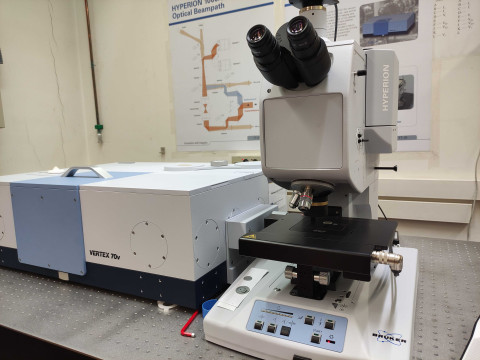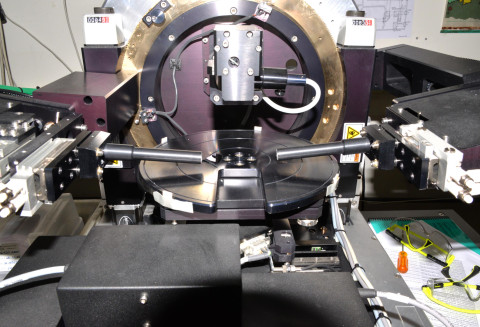Servicio De Espectroscopía Infrarroja Y Elipsometría
Científico responsable
Dr. Carlos Pecharromán García
Técnico responsable
Pedro Rodríguez-Pascual García
Contacto
Localización
Lab 129
ICMM-CSIC, C/Sor Juana Inés de la Cruz 3, 28049 Madrid, España
Medidas y equipamiento
Espectrofotómetro Bruker Vertex 70V con microscopio Hyperion 2000: La configuración experimental permite realizar análisis espectrales en muestras sólidas (tanto a granel como en forma de película y polvo) en un rango espectral de 50 a 18000 cm-1 ( 200 a 0,55 um). Normalmente, los análisis se realizan en transmisión (KBr, polietileno o CSI). Además, se dispone de celdas ajustables para reflexión difusa (superficies rugosas), reflexión especular (superficies lisas) en incidencia normal y rasante (con luz polarizada), espectroscopia de reflexión interna (reflexión total atenuada, ATR). También se pueden realizar mediciones cartográficas de áreas pequeñas con el microscopio Hyperion tanto en transmisión como en reflexión (ATR, especular con objetivo Cassegrain y ángulo rasante).

| 
|
Elipsómetro GES 5E de SOPRA, provisto de una lámpara Xe y un goniómetro, que permite ajustar el ángulo de incidencia sobre la muestra, cubriendo una gama espectral de 190 nm a 2000 nm. Este elipsómetro es capaz de determinar el cambio del estado de polarización de un haz de luz polarizada producido por la reflexión sobre una superficie pulida. Esta técnica está especialmente recomendada para determinar el espesor y el índice de refracción de películas delgadas (de 1 nm a 1 micra). Se requiere una muestra perfectamente pulida con una superficie plana. Además de la elipsometría, puede realizar mediciones fotométricas en un estado de polarización fijo (reflectancia y transmitancia) bajo ángulo variable. Para esta técnica, las muestras deben ser muy lisas.

Muestras permitidas
Las muestras IR y visibles pueden medirse en polvo o en estado sólido. Se eligen diferentes técnicas analíticas en función de la naturaleza óptica de las muestras, así como de su estado. La mayoría de las mediciones son no destructivas.
Para la elipsometría y la reflectometría, las muestras deben ser planas y lisas.
Además el servicio dispone de los siguientes medios técnicos y activos materiales para el cumplimiento de sus propios fines:
- Espectrofotómetros:
Bruker Vertex 70V con Microscopio Hyperion 2000, Bruker iFS 66vs y Jasco UV-Vis V660. Espectrofotómetros con Celdas acoplables (Reflexión Difusa y Reflexión Especular normal; Grazing Angle; Seagull de ángulo variable; Transmisión y reflexión con microscopio Hyperion 2000 (objetivo 4X y Cassegrain 15X).
- Técnicas:
Espectroscopía THZ-IR-NIR-VIS de sólidos en cualquier formato de muestra (de polvo, lámina delgada, masiva, etc), Microscopía IR, Elipsometría espectométrica, espectrometría UV-Vis.
- Ensayos/alcance/muestras:
Espectrofotómetro Bruker Vertex 70V con microscopio Hyperion 2000: La configuración experimental permite realizar análisis espectrales en muestras sólidas (tanto en forma de película, polvo, o fragmentos centimétricos) en un rango espectral de 50 a 18000 cm-1 (200 a 0,55 um). Normalmente, los análisis se realizan en transmisión (KBr, polietileno o CsI). Además, se dispone de celdas ajustables para reflexión difusa (superficies rugosas), reflexión especular (superficies lisas) en incidencia normal y rasante (con luz polarizada), espectroscopia de reflexión interna (reflexión total atenuada, ATR). También pueden realizarse mediciones cartográficas de áreas pequeñas con el microscopio Hyperion tanto en transmisión como en reflexión (ATR, especular con objetivo Cassegrain y ángulo rasante).
Elipsómetro GES 5E de SOPRA, provisto de una lámpara Xe y un goniómetro, que permite ajustar el ángulo de incidencia sobre la muestra, cubriendo un rango espectral de 190 nm a 2000 nm. Este elipsómetro es capaz de determinar el cambio del estado de polarización de un haz de luz polarizada producido por la reflexión sobre una superficie pulida. Esta técnica está especialmente recomendada para determinar el espesor y el índice de refracción de películas delgadas (de 1 nm a 1 micra). Se requiere una muestra perfectamente pulida con una superficie plana. Además de la elipsometría, puede realizar mediciones fotométricas en un estado de polarización fijo (reflectancia y transmitancia) bajo ángulo variable. Para esta técnica, las muestras deben ser muy lisas.
Espectrofotómetro Jasco V-660 de doble haz que utiliza un doble monocromador junto a un tubo fotomultiplicador como detector. Este sistema de doble monocromador proporciona una elevada resolución y una gran precisión en la medida con un rango fotométrico que alcanza hasta 6 unidades de absorbancia, lo que permite trabajar con muestras que apenas transmiten.
- Muestras permitidas:
Las muestras IR y visibles pueden medirse en polvo o en estado sólido. Se eligen diferentes técnicas analíticas en función de la naturaleza óptica de las muestras, así como de su estado. La mayoría de las mediciones no son destructivas.
Para la elipsometría y la reflectometría, las muestras deben ser planas y lisas
La entrega de muestras se puede producir dirigiéndose directamente al laboratorio del ICMM o bien por correo. Las muestras durante su permanencia en nuestro laboratorio, se pueden conservar en condiciones normales, refrigeradas, en condiciones de baja humedad o en vacío.
Los ensayos que se realizan en un laboratorio de investigación siguen una estrategia de investigación científica, lo que hace que se tenga que adaptar a un gran número de sistemas problema. Esto hace que no se puedan implementar medidas regidas por normas industriales específicas de materiales muy específicos. Sin embargo, también se realizan gran cantidad de ensayos de rutina (medidas FTIR en transmisión o en reflexión especular o difusa, elipsometrías, fotometrías) para caracterizaciones rápidas de muestras. Los procedimientos para realizar tales medidas, el calibrado (cuando procede), junto con la forma de manipulación de las muestras, constan por escrito en los manuales y guías de los equipos con que cuenta este laboratorio
ICMM
Sor Juana Ines de la Cruz, 3
Cantoblanco, 28049
Madrid, España
Teléfono: (+34) 91 334 90 00
Email: @email
Oficina de Comunicación/Prensa: @email


Contacto | Accesibilidad | Aviso legal | Política de Cookies | Protección de datos



